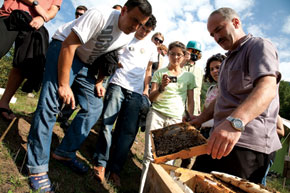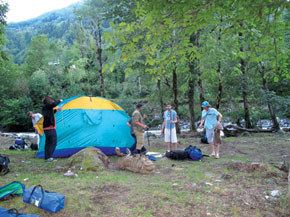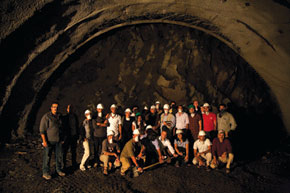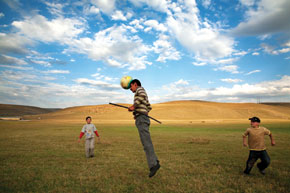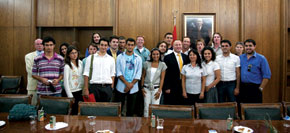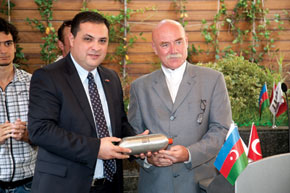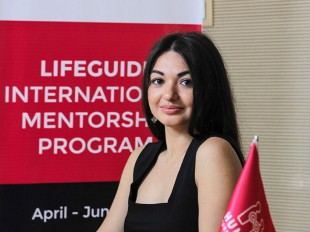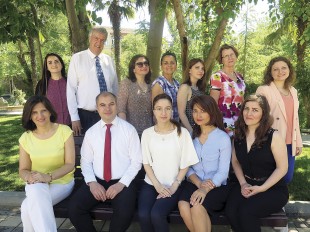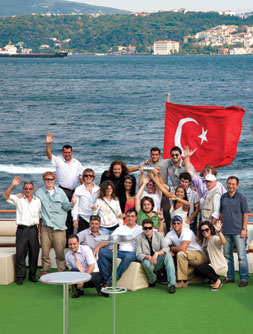 Pages 42-49
Pages 42-49by Thomas Goltz
Here we present the third and final part of the diary of a summer study course organized by Professor Thomas Goltz. It arose out of his Organization of the Black Sea Economic Cooperation simulation course at Montana State University, USA. Students were taken on an epic travel/lecture journey, crossing Azerbaijan, Georgia and Turkey…
The Road to Kars…and to Sultan City
Day Sixteen, August 29; Turkish border/Camili: More than an hour is needed to free the buses from Turkish customs. ‘Technical issues’ range from insurance to ownership but no money changes hands. Still, a bad taste is left in the mouth. After being joined by SOCAR/Istanbul guides Ekrem Sommezisk and Saleh Gulseven, the caravan moves up the 3,000-meter pass overlooking the Machahal Valley, which has now been declared an International Biosphere Reserve. Descending to the Georgian-speaking region now called Camili, our hosts invite everyone up to the local center for eco-tourism to show a film about eco-progress made since the mid-1990s, when they decided that economic salvation for the near totally isolated place was the cultivation of the unique and native Caucasian bee. A night under the stars by the side of the twin babbling brooks follows; a little chilly, but utterly delightful.
Day Seventeen, August 30; Camili/Artvin/Kars: The team breakfasts on organic honey and jams produced in Camili, followed by a presentation on the cultivation of Caucasian queen bees, which has transformed Camili from being a poor and utterly remote area into being a (relatively) wealthy outpost of entrepreneurs who really know their bee-raising craft.
“I can only give you the most superficial information—really informing you about the delights of life as an apiarist would take three months!” confides Master Apiarist Nuri, who also serves as the local imam. He explains how one standard box-hive might produce something like $3,000 of honey per year; but the same hive, used as an incubator of queen bees can be sold for something like five times that much. “You do the math,” glows Nuri, bees crawling all over his hands.
Then the HoC’s cell phone rings. It is Nihat Gokyigit, a native of the region and the founder of the Turkish mega-company, Tekfen, who has made this part of the New Silk Road Summer trip possible. After a quick briefing, the HoC sticks the cell phone into the buses to ask if anyone has anything to say.
“Thank you, Nihat Bey!!” comes the collective cry.
The caravan pushes on through the tributary system that feeds the Choruh River, climbing toward Kars on the denuded eastern Anatolian. Seemingly every highway in the region is under reconstruction. Inevitably, a rock makes its way through tire rubber and the caravan grinds to a halt, with testosterone-driven discussion spent on the finer points of changing a flat tire. This allows the NSRS youths to engage in a soccer match with local shepherd kids, who mysteriously appear as if from nowhere, and win. Dinner at Kars is in a local kebab joint that does not serve alcohol. It is the first real reminder that the NSRS team is in Turkey, and during Ramadan.
Day Eighteen, August 31; The Steel Silk Road: The BTK tunnel construction civil works are being done by the Ozgun Construction Company, and it is truly breathtaking in scope. Multiple tunnels, viaducts, dual-tracks—wow! The team is led to the main tunnel site and then down the emergency shaft to the rock-face 140 meters beneath the Georgian-Turkish frontier to receive a briefing. If the climb to 3,400 meters above Shah Dagh national park in Azerbaijan was the literal high-point of the trip so far, the glimpse of life as a troglodyte is the literal low-point. Laura Villegas chalks her name to a stone on the rock face that will be blown up the next day…
It is 8 PM and dark by the time all elements of the group gather at the entrance to the ancient Armenian capital of Ani. Special guest Nigar Goksel (and Turkish Foreign Policy Journal editor) decides to split her time between the two buses, relating her years of experience and analysis to one of Turkey’s most perplexing questions: how to be ‘nice’ to Armenia by opening up the border to please the West while not alienating Azerbaijan…After a tea stop in Horosan, the caravan hurtles through the night toward Erzurum.
September 1, Erzurum/Erzincan/Sivas: While HoC brings Nigar to the airport, photographer Michael Kautz speed-tours the NSRS team through Erzurum, where he worked as a teacher of English for the past year. The cat-pack gets a glimpse of one of Turkey’s most conservative cities, including the main highlights such as the Double Minaret and Lale (tulip) mosques with their ornate tiles before boarding the buses for Sivas via Erzincan (the highway parallels the upper Euphrates River) for a lecture on the creation of Republican Turkey by Bilgi University Professor Dr Mete Tuncay.
Day Twenty, September 2; Sivas/Ankara: The Tuncay lecture is a highly nuanced ride through late-Ottoman constitutionalism and the rise of the Committee of Union and Progress that would lead the Ottoman state to join the Central Powers on Germany’s side in WWI and spell the end of the 500-year old Ottoman state in 1918. This was also the period when a young officer (and lower CUP member) by the name of Mustafa Kemal would make his play for power.
The Tuncay extraordinary tour d’ horizon is particularly apt in light of the referendum on constitutional changes set for 12 September 2010. Airways are dominated by animated (and often vitriolic) debate, and every street in the country seeming plastered with signs and posters advocating either a “Yes!” (Evet!) or “No!” (Hayir) vote to the ruling political party, the Justice and Development Party (AKP) of Prime Minister Recep Tayyip Erdogan.
The NSRS crowd does a brief tour of historic monuments in Sivas before the 300 kilometer drive to Ankara, interrupted by an unscheduled stop at the ancient Hittite center of Hatusas and the incredible wall carvings at a supposed temple complex called Yazilikaya, or ‘Inscribed Canyon,’ posing with the gas-bomb in front of 5,000 year old relief carvings.
Day Twenty One, September 3; Ankara: The digs for the night have been arranged by SOCAR/Turkey via the Ministry of Energy and Natural Resources, and specifically by Energy Minister Taner Yildiz. After a light security check (the “gas-bomb” makes it through the metal-detector), he greets the team in the morning.
“I congratulate you on your initiative, which is so much larger than what I suspect any of you can conceive,” says the minister. “Without social, academic and indeed adventurous input, a project such as a pipeline is merely a piece of steel put in the ground. Your multinational academic adventure is an important element in insuring that any pipeline to come out of your exploration of the East-West Southern Corridor will create understanding between peoples that will lead to peace, as opposed to war over energy resources. I would like to reiterate my thanks to each and every one of you.”
The next stop is the fabulous Museum of the Civilizations of Ancient Anatolia, located in the citadel district of old Ankara/Angora, which includes the unique Hittite collection brought from such places as Yazilikaya, followed by the Ataturk Mausoleum, the huge granite structure devoted to the memory and legacy of the founder of modern Turkey whose secular reforms, designed to remove Islam from public life, are still much debated today.
Following lunch, the NSRS team shuffles back over to the Energy Ministry to listen to an excellent presentation by Dr. Cenk Pala, who details the story of the Nabucco pipeline project, ending with how it got its name: the architects had dinner in Vienna, and were gifted tickets to the opera playing across the street: Verdi’s composition concerning Nebuchadnezzar, some 4,000 years ago…
Day Twenty Two, September 4, Ankara-Istanbul: The highway between Izmit and Asian Istanbul starts to crowd up, and Nihat Gokyigit is waiting at the Botanical Garden Named In Memory of Nezahat Gokyigit.
‘Our world is exploding in population,’ announces Nihat Bey. ‘We must feed ourselves, or die! Some say that creating the super legume is a dream. But how can we not try?’
The HoC wants to be like Nihat Bey when he grows up.
‘Nihat Bey! Nihat Bey!’ chant the cats at the group picture.
Actually, what they say instead of ‘cheese’ is ‘bees.’
Then comes the bridge over the magical strait, at the end of which is another message: Welcome to Europe, it reads.
The grueling, three week and nearly 3,000 kilometer (2,000 mile) 2010 New Silk Road ‘Gas Odyssey’ feels like it is nearing an end.
Day Twenty Three, September 5; A Visit To The BSEC HQ: Ambassador Leonidas Chrysanthopoulos, the Secretary General of the Organization of Black Sea Economic Cooperation (or ‘BSEC’), has thrown open the doors his lovely facility on the Bosporus. Then there arrives a special guest: Dr. Prof Ilter Turan, rector of Bilgi University, giving a wide-ranging, clever and often funny address that rivets all in its scope and substance. One burning question is about Turkey’s relations with the EU. The jist? Why beg for membership in a bankrupt organization when the Turkish economy is ablaze?
Day Twenty Four, September 6; A Bosporus Cruise: Nihat Bey has directed his Tekfen Holding folks to provide a different sort of day for the exhausted NSRS travelers—a Bosporus tour. The NSRS group numbers some 25 individuals, while the boat has a capacity of something like 250.
The cruise goes all the way to the Black Sea and back, tracking tankers and even the US Consulate ‘fun’ boat, the Hiawatha, while NSRS check out dance moves in various traditions beneath both Bosporus bridges…
Day Twenty Five, September 7; The still-not-officially opened SOCAR/Turkey HQ has gone out of its way to prepare for the official transfer of the “gas-bomb” from the NSRS team to Seymur Agayev, the regional boss. Not only is a miniature oil donkey pumping water from a perennial well in front of the building, but Seymour has managed to collect the local media despite the fact the day is the first day of the Ramadan holidays.
Cameras blaze as the HoC details the now standard mantra about topping mountains, crossing rivers and penetrating forests. His primary message is about the group’s debt of thanks to those who made the NSR 2010 possible. These friends include everyone from Azerbaijani Airlines to the Azerbaijani Ministry of Foreign Affairs to the Minister of Ecology to BakCell. Nihat Gokyigit and his TEMA Foundation are rightly praised for the ‘three Bs’ (the Camili bees, the Botanic Garden and then the Bosporus boat tour. He also thanks the Turkish Petroleum Company (TPAO) and the German RWE and then finally enunciates an extraordinary word of humble thanks to the State Oil Company of the Azerbaijani Republic. It was SOCAR’s offices and personnel that had been so indispensable for the journey—and for the first time, Azerbaijani institutions had led the sponsorship pack—and how! A special guest is Batu Ersoy, the young CEO of Turcas, who makes a surprise appearance.
And suddenly, the three weeks of travel is over.
Perhaps there were teary goodbyes among the NSRS participants, but one thing is certain. The New Silk Road Summer Adventure in Energy and the Environment cannot be evaluated by any ‘results’ demanded tomorrow, next week or even next year. Ultimately, the event will be evaluated by what the MSU students and their Azerbaijani, Turkish and Georgian colleagues do with their experiences a decade or more from now.
We leave the reader with the first note of thanks received after the trip; a second is not needed:
Dear Professor,
It seems like in the past 3 weeks we have been living in a parallel dimension...the kind of story where one day in one world equals one year. After reviewing notes, pictures and memories, I look back and cannot feel anything other than grateful. Thank you so much for giving us this opportunity and for putting together this wonderful adventure. I am sure it will take us some time before we can assimilate "reality" again. For now, everything that is physically near feels cold, distant, frugal and somewhat foreign... It is like we had become the character of a story, and we are now back from the book into reality. I am a little sore from growing so, but in a week or so I hope the ache and the jetlag are gone. Thank you so much. Safe travels,
Dan Brooks
NSR
CROSSING A BORDER AND GETTING UN-STUNG BY BEES
The late August sun stood at midday, and we Americans watched enviously as our Turkish counterparts scampered across the border in the Turkish Citizen Express line while the rest of us were herded into the sweltering Foreign Citizens Shakedown corridor, along with all manner of rabble. It just wasn’t fair.
After making it through the border, we found some shade while our drivers rectified some ‘technical’ details with their vehicles with the help of ‘The Dictator’ (our beloved Prof Goltz) that took nearly two hours. Two students decided that they have had enough of the heat and threw off their shirts to descend a boulder-strewn cliff face to plunge into the cool waters of the Black Sea. Suddenly, the first of the missing buses emerged from the customs area. In the cab was the Dictator, wearing something approximating a smile on his face… The drivers looked relieved that the Turkish-Georgia border was behind us.
The Turkish Black Sea coast was exquisite - a rocky shoreline touching forested hillsides and rocketing up to an incredibly pristine, clear blue sky. Turning south at a place called Hopa, we began the climb up to the vertical world of the Machahal Valley, with birds-eye views of mountain ranges. The farthest away wore glittering snow caps—the Caucasus range, hundreds of miles away, and sharp as a butcher’s knife.
From a 3000 meter (12,000 foot) pass, we descended into the Machahal Valley along roads that were narrow and soft with new gravel on sharp turns. Thankfully our drivers were professionals and got us safely to our destination - a little campground wedged between two gushing mountain streams at a place called Camili…. We finished pitching camp just as darkness fell and began building a fire while we waited for our hosts to deliver a delicious camp-side meal of lamb, pasta noodles and an amazingly sweet baklava. After our repast, we marched up the hill to an ‘eco-tourism house’ where we were shown a video about the valley and its economic and environmental progress over the last two decades and under the stewardship of the local-lad-done-good—Nihat Gokyigit, co-founder of the giant Turkish construction (and now mega-‘holding’ company), Tekfen, which is involved in projects from Russia to Libya. Now retired, and a spry 85, Nihat Bey has embraced philanthropy in his native region. In this instance, he crafted a business model for local bee keepers in Camili to bring the area from utter obscurity and poverty into the modern world.
What was unique about the project was not the honey, but the bees themselves. Isolated in a ‘cul de sac’ due to the mountains, the Camili bees (technically, the Caucasus Bee) had preserved a unique genetic make-up that included both a docile nature as well as a reputation for being the most efficient honey producing bees in the world. But, as explained to us, the honey is not the money in the hives; the real profit is the production of queen bees for export. They sell for around $40 a head, and raising them for sale makes a hive worth some ten times more than one merely devoted to making high-grade Camili honey.
As we exited the house to head down the trail to our campsite we were greeted by the echoes of gunfire resonating around the valley, but the ruckus was only locals celebrating the fast-breaking of the holy month of Ramazan. Even though I had pitched myself a tent, I decided it would be best to sleep under the stars on a wooden stage bordering one of the streams. The clear night sky viewed through the tree canopy revealed thousands of stars that grew exponentially as the light from the fire died down.
Richard Gauron: The Call to Prayer Allahu Akbar…Allahu aKBAR!
La illaaah il Allah…
The early morning prayer started slowly, entering my consciousness with stealth before finally waking me in a state of confusion.
Where was I and what was that eerie, almost sinister sound?
I went to the window to close it, but was transfixed. The echoing sound of the call to prayer had started with one voice, but slowly gained others, turning into a discordant chorus, ringing over the silent city—Kars, on the Armenian frontier. That moment could quite possibly have been one of the most alien of the trip; it reminded me of a clap of thunder that would wake you as a child, followed by the slowly growing sound of rain, almost intimidating, that would then keep you awake. The call to prayer would follow us as we drove across Turkey, from Kars to Erzurum, Sivas, Ankara and then finally Istanbul, with every venue seeming to have a different emotional texture.
In Istanbul, for example, the call at midday while surrounded by millions of people had a much less sinister feeling than my first exposure to the dawn call at Kars. I would stop and sit in the park in front of the Blue Mosque and listen to the sound, as it instantly reminded me how far away from everything familiar I was. Indeed, the call to prayer for me became a call to look around, step out of my academic bubble and just embrace the moment of where I happened to be.
Dan Brooks
NSR
Kars, Ani and the Baku-Tbilisi-Kars Railway to London and Beijing
Kars, Turkey is located just north of the Northern Anatolian Fault line, and known for its seismic activity, better known as earthquakes. The danger was all too apparent when we ventured into our rooms to find the spider webs of cracks running along the walls and doorframes due to the stresses of plate tectonics—and ours was a new hotel.
After a quick breakfast, we began a march through the market, with our ultimate destination Kars Castle. The cobble stone streets, many flanked by handsome, black basalt buildings dating from the period 1878 to 1920 when Kars was part of Russia. Before that it was Ottoman; before that Safavid; before that Seljuk; before that Armenian; before that Georgia; before that Byzantine…you might say the place has a mixed pedigree…
This sense of changing hands was underlined by the main mosque near the market, which was clearly an ancient church converted for Muslim use. While the exterior was no doubt the same over the centuries, in the interior crosses and icon paintings of holy figures had been replaced with Qur’anic text, and whatever seating removed to make room for worshippers to prostrate themselves during prayer. The tiled roof had grass and weeds poking out, giving it a very ancient feel.
Nestled under a cliff face on the western-most hill in the city, Kars castle’s location enabled would-be defenders to focus on attackers from the east. Constructed in 1153, it stands almost completely intact today.
The next stop on the day’s itinerary was a visit to the future, namely, the BTK ‘Steel Silk Road’ railway project designed to make a freight and passenger link between Kars, Tbilisi and then Baku and thus bolster commerce in the region. (Later we learned that this was just the tip of the iceberg and that the BTK project was the (almost) final link in a rail system that would ultimately connect London to Beijing.)
What we were to be shown were the main BTK construction headquarters followed by an exclusive below-ground look at the main, five-mile tunnel, slowly moving east from Turkey towards Georgia with each blast of dynamite.
It was surreal. At the tunnel entrance, we donned hard hats and respirator masks and then plunged into the earth. As we reached the end of the shaft, I wandered around, soaking up the troglodyte experience until I discovered a shovel—a perfect prop for the obligatory photo-op at the rock-face in order to make the disingenuous claim that we had assisted in the mega project...
With the sun only a couple hours from setting we were determined to see Ani, the ancient Armenian capitol overlooking the Arpacay River, before nightfall. Our buses arrived at dusk just as the open-air museum was closing, but our Bilgi University peer Nihan Sarakaya had high-level connections around here through her uncle and we were allowed in just as everyone else was getting ushered out.
Unlike Kars Castle, which guarded a city, the city of Ani was not only a well-known stop along the Silk Road, but a huge fortress itself and built atop a triangular jut of land shielded by the Arpacay River, thus leaving only one side to defend by means of its massive walls. The walls still stood, but aside from a number of tottering Armenian churches and other structures, the once thriving metropolis looked like it had been hit by an earthquake—which it had been, again and again.
Team Shepherds versus MSU on Ardahan/Kars Playing Pitch
By Richard Gauron
….then Dan attempted to break the ice by purchasing a sponge ball from the beautiful Georgian girl in the Batumi toy store, using the interaction to talk to her. Sadly, the girl’s English was more or less non-existent and our Georgian being entirely non-existent, we were forced to part ways with a single memory of her - the ball, which ended up wedged in the back of the bus with me as we pushed out of Georgian and into eastern Turkey.
Here, the roads were in pretty rough shape, and our buses and vehicles took quite a beating, often over-heating and resulting in forced stops. Then the command vehicle got a flat and everyone had to mill around while five or six men speaking multiple languages… took turns at finding the correct sized jack and removing frozen lugs. What fun.
…. A few of us decided to make the most of it and get a little exercise, and I dug out the sponge bob ball to pass around on the road. An errant kick sent it down an embankment and into a flat, grassy field, and the game moved down there. Then, in the distance, a shepherd migrated towards us and joined in the fun, while still clutching his staff, making him slightly unwieldy but still an enthusiastic player. He couldn’t have been more than 13. Then two more youthful shepherds arrived, and then more until before we knew it, it was Americans versus Shepherds in a pick-up game.
Whack, kick, pass—header, and SCORE!
On the road above us, the tire was eventually fixed and it was time to board the bus and go, and we said good-bye to our newfound shepherd friends. But after seeing how much fun they had had, and the smiles on their faces while playing with the ball Dan had bought in Batumi as an excuse to talk to a beautiful girl, we turned around and handed the ball to the eldest of the shepherd team. As we looked back, they were still playing with it—a wise purchase indeed!
By Can Ogutcu
Of Ankara, Azerbaijani Energy—and Nabucco
Ankara was a key destination for us to better understand the Turkish side of the energy policies regarding the proposed Nabucco gas pipeline project as well as other energy transportation systems such as the BTC and BTE existing pipeline routes. Accordingly, our first stop was at the Ministry of Energy and Natural Resources, where Minister Taner Yildiz greeted us in person and then held a press conference where the NSRS team got to ask all the questions. (Our “gas-bomb” was the centre of attention.) First, Minister Yildiz presented us with Turkey’s vision of the Nabucco project. He stressed that Turkey was becoming a regional energy hub combining Russian gas from the Blue Stream, Iranian gas, Iraqi oil from Kirkuk and Azerbaijani oil from the BTC pipeline. He also underlined Turkey’s position as a huge energy market, investor, trader and partner in the global discussion about climate-change.
As for the Nabucco project, it is viewed by Turkey as a project that gives Europe access to Caspian/Central Asian gas resources directly without going through Russia, which already supplies Western Europe with 65 per cent of its gas. Thus, Minister Yildiz argued how strategically important it was economically and politically for Turkey to become an energy hub and transit corridor. (Notably, the next chapter to be opened in Turkey’s EU accession negotiations is energy)
Following our meeting with Minister Yildiz, we were next given a stellar (and often very funny) lecture on Nabucco by Dr Cenk Pala, formerly of Turkish state pipeline authority BOTAS, and now with the Austrian firm OMV, during which he explained how the mega pipeline project got its name. Following a marathon negotiation session of the still nameless project in Vienna, Dr. Pala and his energy associates took a break by attending an opera by Verdi one night—and lo! ‘Nabucco’ was born.
“It was poetically right, and a lot easier to remember than something like ‘The trans-Caspian Turkmenistan-Azerbaijan-Georgia-Turkey-Bulgaria-Romania-Hungary-Austria pipeline, or TAGTBRAP,” Dr. Pala chuckled.
Logan Brown
TURKEY: An Emerging Power
Turkey is asserting itself in ways many never thought possible. It has adopted a clear vision to boost its role in its region and the world, develop and improve an already booming economy and strengthen its internal democracy. Turkey is somewhat of an anomaly in the world today; it is both an emerging democratic power and a Muslim country. The current regime is also committed to assert its newly-garnered influence in the Middle East and larger Muslim world, while strengthening Islamic traditions at home. Simultaneously, it remains committed to advancing its application to become a full member of the European Union and solidify itself as a world and regional power.
Still, a self-confident Turkey that is committed to boosting its regional role (by building and strengthening relationships with countries like Iran and Russia, for example) has strained the ‘traditional’ relationship between Turkey and the West (and particularly with the United States).
The Republic of Turkey was formed as a modern state after the collapse of the Ottoman Empire in WWI in 1918, and subsequent attempts to partition the remaining ‘core’ Turkic state among diverse powers between 1919 and 1922. The successful resistance movement was led by Mustafa Kemal (later ‘Ataturk’), and culminated in the recognition of the republic by the international community with the Treaty of Lausanne, 1923. But this was only the beginning. Under Ataturk, Turkey adopted wide ranging social, legal, and political reforms that came to be known as Kemalism.
According to George Friedman, a geopolitical strategist, these reforms were not only essential in empowering a revolutionary new form of government; they were essential for Turkish national survival. The main reform and arguably the foundation of the Kemalist ideology was secularism. Ataturk equated a secular society to the modern nation-state in which Islam would be a matter of private practice, and not the center of the state. Ataturk did not suppress religion, but rather diminished its role in the public sphere. Turkey is in a unique position right now. It is the most progressive country in the Middle East and one with close ties to the West. It is ready to lead and its foreign policy is aimed at building that leadership role. Foreign Minister Davutoglu believes that “…in this new world Turkey [will] play an increasingly central role in promoting international security and prosperity…and our foreign policy ensures that Turkey can act with the vision, determination and confidence that this historical moment demands.”
In the next decade Turkey will become more powerful and assert that power in various ways. When it sees an opportunity to “flex its muscles,” it will do so, and on a scale that many had heretofore thought impossible. Turkey is self-confident, expects great things of itself and is committed to lead in its region. The economic prosperity the Turks are enjoying will only solidify this leadership and self-confidence. Now is not the time for the West to abandon Turkey, but to embrace it.
Dan Brooks
New Silk Road
Bosphorus Dancing
The itinerary for the afternoon of September 6th placed us on a Bosphorus boat tour/lunch courtesy of Nihat Bey. We walked north towards Kabatas and the dock where our boat was moored. As we waited for the crew to finish servicing the boat we drank tea and I haggled a street vendor for a pair of aviator sunglasses; I talked him down to 7 lira from his initial 40. As we boarded the 3-story, cruise/diner boat named Keyif Style, which had once been graced by Queen Elizabeth, anticipation turned into excitement as the boat began to leave the pier. Waiters brought us ice-cold beverages and we made our way to the top deck where a photo op of the group with the now famous ‘Gas Bomb’ and SOCAR flags commenced. Professor Goltz tried to provide us with information about all the areas we sailed past …. After eating a feast below deck we made our way topside to engage in some dancing as the DJ downstairs started playing some popular dance music. Although we made it all the way to the northern entrance of the Bosphorus and back, the trip seemed to end all too quickly. Before we knew it we were offloading, having left behind numerous laughs. Thank you Nihat Bey!
The pinnacle of the trip occurred the next day as we handed off the symbolic ‘Gas Bomb’ to SOCAR Turkey, after having made the trip across 3 countries, thousands of miles, visiting numerous historical significant venues, and sharing meals with newfound friends I will never forget. As Professor Goltz stood in front of the cameras, handing off the ‘Gas Bomb’, I reflected on all the fun I had through the new places I had visited and people I had met. To those who made it possible, thank you. To those new friends who made it fun, may we remain friends forever.
